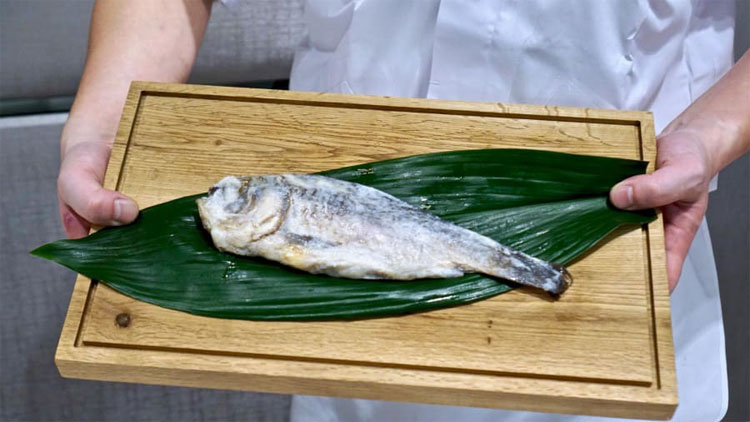If you think of the original meaning of sushi as raw ingredients, you are wrong!
Do you believe it - knowing that the original version of sushi is a fermented fish, for the whole year? It is called Funazushi.
Today, anyone who doesn't know Japan's famous fresh sushi. However, you may be shocked to know about its origin.
Funazushi - the "smelling" source of sushi
For thousands of years, along the Mekong River, Southeast Asian residents with wet rice cultivation have learned how to store food to store through the rainy season. By the 2nd century, the same method was recorded in China.
By the 7th and 8th centuries, the method of fermenting food from Southeast Asia and China gradually circulated to Japan. People of cherry blossoms start brewing fish with salt and fermented rice - called Narezushi.

Narezushi.
Especially Shiga Prefecture, with the largest Biwa Lake in Japan. Lake Biwa is home to funa fish - a typical Japanese carp, which is easy to clean the intestines and fish scales, which helps to preserve longer.
Therefore, Shiga Prefecture has developed an extremely famous fermented fish , called Funazushi . Also because the silage method produces lactic acid (which helps the fish does not ripple), Funazushi possesses sour taste to . very sour, depending on the processing place!
Again, Funazushi is just a small branch of Narezushi, but it has the longest life and still exists today. Even so, they still have to undergo certain changes.

Shiga Prefecture has developed a very famous fermented fish funa, called Funazushi.
Today's Funazushi
By the 14th century, people did not steam rice and ferment it to marinate the fish. Instead of rice vinegar. This helps the incubation process take place faster but still retains the characteristic sourness.
At the same time, they combined eating Funazushi with white rice - we have begun to see the shape of modern sushi.
By the 18th century, "modern" sushi was completed in Osaka and spread to the ancient capital of Edo (present-day Tokyo), becoming very popular.
A book records that, every 10 thousand square meters, a soba noodle shop and 2 sushi salons are found. That is, the number of sushi shops is double that of soba noodle shops!

Sushi paintings by painter Utagawa Hiroshige in the 19th century.
However, because it is still related to fish fermentation, the shops need a long time to process. They must constantly hang the sea in front of the door to . report the time for the guests!
By the 20th century, the presence of modern refrigerators brought a new turning point for sushi. People do not incubate fish but use fresh, chopped pieces to put pieces on rice balls (still mixed with vinegar). Which is not necessarily fish anymore, can be replaced by many other seafood.
From the end of the 20th century until now, sushi has become the "national" dish of Japan, can be processed and enjoyed quickly - neatly and quickly in the day.
And not many people know about Funazushi of the old days, although this fermented fish still persists with the same time.
Enjoy Funazushi
As mentioned, Funazushi's highlight is its characteristic smell, accompanied by a rather sour taste, like Western blue cheese or yogurt for a long time. It also has salty taste.
Funazushi fish can also be served with many other items, such as porridge, or deep-fried to make tempura.
Japanese people also drink sake or green tea to harmonize Funazushi's strong flavor. According to handed down, this dish is good for digestion and health care, beauty in general.

Funazushi's highlight is its characteristic smell.
But about 50 years ago, Lake Biwa funa fish became less and less, making this dish in Shiga's hometown price up. Moreover, because processing the feat that Funazushi gradually absent from the dining tables in modern Japanese families.
Fortunately, Funazushi stores in Shiga prefecture - including the Kitamura family store, have undergone 18 generations of propaganda - the "culinary museums" of the original sushi.
Hopefully, if we have a chance to come to Japan later, we can still challenge ourselves with this "smelling" but very interesting Funazushi!
- Sushi is world famous and the birth coincidentally
- This information will startle the believers of sushi
- Kisaku Suzuki - The person who revolutionized the sushi industry in anger
- Why does Japan take a decade to train a professional sushi chef?
- 8 things to know when eating sushi
- Eating sushi can harm the heart
- Scientists are tame bluefin tuna to get enough sushi ingredients
- Video: The process of producing crab meat 'not made from crabs' in sushi
- Why eat sushi for a long time?
- The frightened man spotted the spider looking like a piece of sushi crawling in the house
- Eating lots of sushi is harmful to health
- Unique sushi made from glowing fish
 'Fine laughs' - Scary and painful torture in ancient times
'Fine laughs' - Scary and painful torture in ancient times The sequence of numbers 142857 of the Egyptian pyramids is known as the strangest number in the world - Why?
The sequence of numbers 142857 of the Egyptian pyramids is known as the strangest number in the world - Why? History of the iron
History of the iron What is alum?
What is alum?